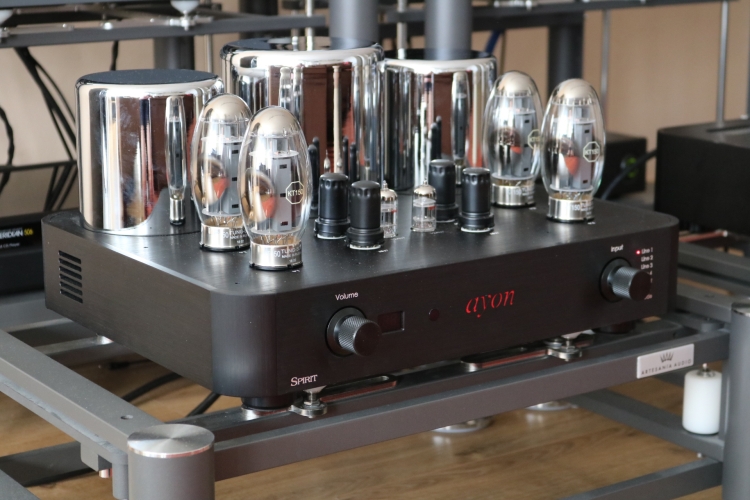
Review samples supplied by Mafico
Retail Price in the Netherlands: 5.890 euro
In the Ayon Scorpio review, I mentioned that a review of the Scorpio’s bigger brother, the Spirit III would follow as soon as that amp was available. And indeed, not very long after publishing the Scorpio review, Hein van der Klaauw delivered the Spirit III, as well as an Ayon CD-10, entirely in line with his habit of always bringing something extra:-)
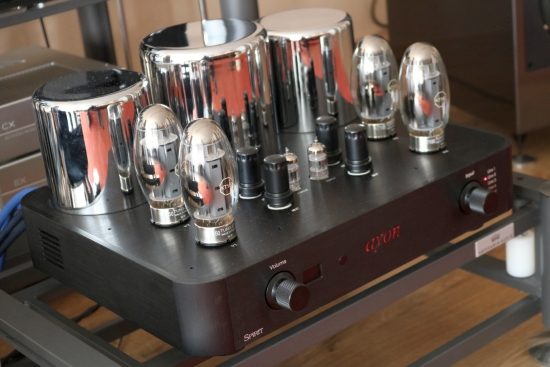
Technical
What differentiates the Spirit III from the Scorpio? Both amps use a Push-Pull configuration and both have the Intelligent Auto-Fixed-Bias (AFB) circuit and tube test program. Both amps have relay-driven input switching, which can only be done from the device, not the remote. But that’s ok for me because the important thing is that the volume can be controlled remotely. Now, that’s where the differences start popping up because whereas the Scorpio uses a potentiometer, the Spirit III uses an electronically controlled analog resistor switching circuit.
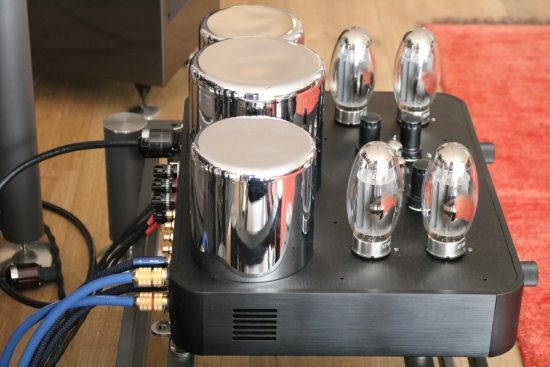
All Ayon products are built incredibly solidly and so is the Spirit III. With 46 x 34cm versus 48 x 37cm and 29kg versus 32kg, the Spirit is deeper than the Scorpio and slightly wider and a bit more heavy, but lifting it and moving it around is still doable by a single person. Rather than the Scorpio’s single speaker connectors, the Spirit III offers 4-ohm as well as 8-ohm tabs and the connectors have been upgraded to the higher-end WBT NextGen type. The transformer housings are the same size as those on the Scorpio and of the same material (Aluminum) but they are Chrome-Rhodium-plated rather than matte black. Whether or not the transformers inside have a different size or rating, I can’t say.
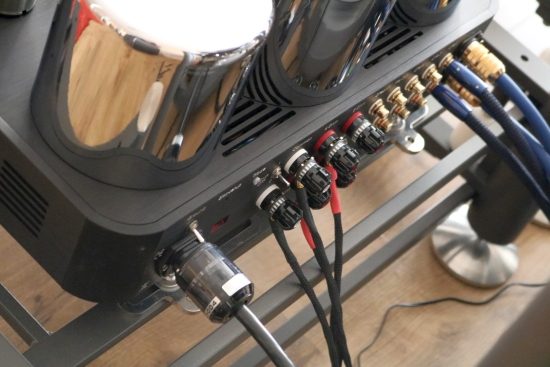
The Spirit III’s preamp section uses the same 12AU7 tubes as the Scorpio but the power amp section’s driver tubes are different: four 6SJ7 metal tubes rather than the two 12AU7 glass tubes for the Scorpio. Indeed: those black units are tubes, not capacitors. Very conveniently, the Spirit III also offers XLR inputs and pre-out and main-in connectors, for connecting an external preamp or power amp.
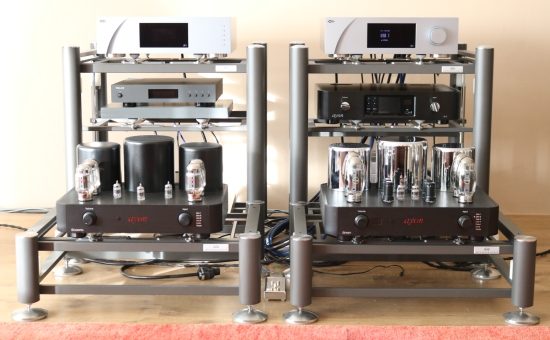
Left: Scorpio, Right: Spirit III
The most striking difference between the two amps is that the Scorpio uses KT88’s and the Spirit III uses KT150’s. This is also reflected in the power rating with 45 watts versus 65 watts, both into 8 ohms. The increase in power is not as big as I would expect, given that other KT150 amps deliver 75-100 watts using these tubes. But watt ratings are not the only thing that matters, as it would soon turn out that the Spirit III has power and control in spades, to drive the Wilson Watt/Puppy 8 as well as Kroma Audio Carmen speakers perfectly.
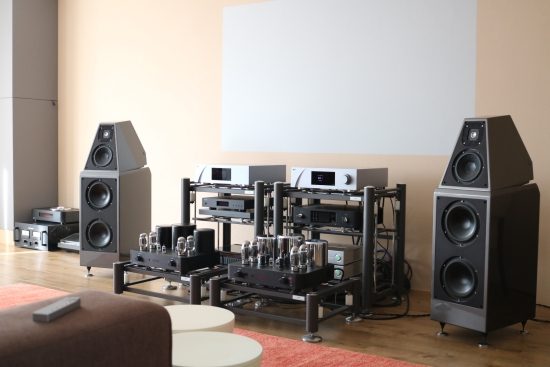
System Context
I used the Spirit III together with the CH Precision C1 DAC/controller, connected via an AudioQuest Water cinch interlink. I also tried the Cardas Clear XLR and while it sounded more refined, I found the Water to make a more synergistic match, making the best of the Ayon’s strong points. Speaker cables are the Jorma Design no.3 (via the 4-ohm outputs) and speakers are the Wilson WP system 8. The source was either the Melco N1ZH via a dedicated network cable or the Antipodes CX+EX via USB, both directly into the C1.
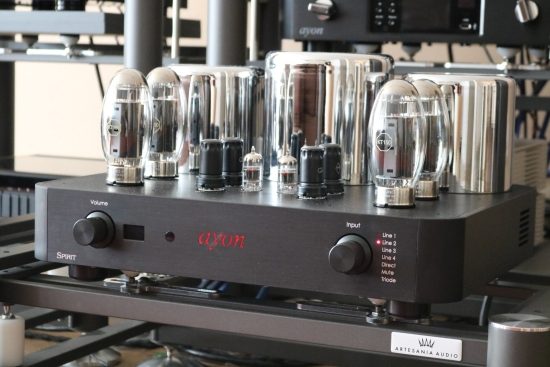
Running in
Some audio components don’t sound very good until they have been used for hundreds of hours. Fortunately, so far, this does not go for Ayon. There’s no sharpness, no edge or glare: their products always sound great right out of the box. However, they do undergo a subtle change as they run in. I find that the manual is pretty much spot-on when it states that extended burn-in is done in 30-50 hours of regular music playing. For me, the biggest change was perceived after three weekend days of playing for about 8 hours and about four 1-4 hour listening sessions. Somewhere at this point, I noticed that the amp started to sound fuller and more sonorous and also a little bit more relaxed while retaining its impressively articulate and dynamic behavior.
The manual offers a very clear explanation for the Running In effect:
“this is partially due to a residual polarization of the dielectric materials used in the PCB like resistors, capacitors, chokes, transformers, and internal wiring. As music is played through the unit, the electrical signal will gradually anneal these materials. The break-in process will occur naturally as music is played through the system.”
Intelligent Auto-Fixed-Bias (AFB)
The Ayon Spirit III uses a so-called AFB circuit that adjusts the bias automatically but only when there is no music playing. This way, the user does not have to measure or adjust anything yet, unlike is the case with some auto-bias systems, there is no loss of power or dynamics. If desired, the automatic bias circuit can also be triggered by a button on the rear panel to achieve maximum adjustment in comparison to the mains voltage and this takes only a couple of seconds. Additionally, a tube test program can be activated by running the same setup but during start-up of the amp. This process takes more time but will run elaborate tests of all tubes and report any deviating findings on the rear panel display.
The Scorpio also has this system but I did not try manually triggering it prior to writing the review. This time around, I have done so, with both amps actually, and the results are very similar. What happened in the cases was that the sound after recalibration was analogous to re-adjusting the lens on a video projector after it was slightly out of focus. Just as the video image, the sound became clearer and more focused, while retaining the amp’s character. Now, these differences were certainly not night and day, and the sound prior to manual calibration was already the opposite of fuzzy but still, the difference is noticeable and worthwhile. The manual advises after this initial calibration to perform this bias setup once a month.
Triode and Pentode mode
Triode mode is another feature that the Scorpio also offers but which I did not try prior to putting the review online. Meanwhile, I have indeed tried the Triode mode with both amps. Contrary to the PrimaLuna Dialogue Premium which I preferred in Triode mode, I definitely preferred the Ayon Scorpio and Spirit III in Pentode mode. I think this is due to the different presentations of these amps. The PrimaLuna is also a powerful sounding amp but it can be a little rough, especially in Pentode mode and in this case, the Triode mode adds a nice amount of smoothing as well as refinement to put everything more into perspective. The Ayons, however, are considerably more refined to start with and therefore, in my opinion, do not need any mellowing.
With the Ayon Scorpio or Spirit III in Triode mode, the amps sound more relaxed, smoother and more liquid and in some cases, this has its appeal, but in the process, a portion of the Ayon-typical speed, slam, and dynamics are sacrificed. In another situation or for another listener, this lusher sound may well prove more ideal but for me, with the Wilsons, at least, this mode was not for me. In any event, the button is there and it’s easy enough to just see for yourself which mode you prefer. The SET Crossfire III that I listened to a little longer ago, by the way, is a pure Triode amplifier but one that fully retains the powerful Ayon house sound, in addition to offering that elusive purity that only SET amps seem to offer. So, you see, Triode sound does not necessarily have to be analogous to “romantic” or “mellow”.
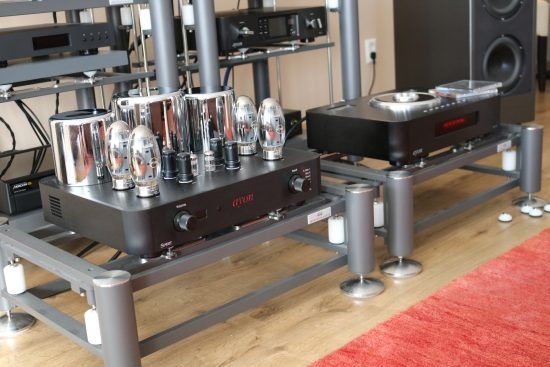
Listening
The first thing I noticed with the Spirit III, after having listened to the Scorpio for about a month, was that it has a different character, even though I also heard a very strong family resemblance. The resemblance is in terms of enthusiasm, tight bass control, dynamics, and the overall sense of power. The difference, I think, is mostly due to the difference between the KT88’s and KT150’s. Even though the implementation is potentially even more important than the tubes themselves, so far, I’ve always been able to link certain aspects of the sound to KT88’s and KT150’s in particular: the former always seem to be slightly rich and warm and the latter always seem to be very linear, articulate and extended and the same was observed here. I have to say that the KT150’s really are very impressive tubes. Perhaps for some people or some tastes, they are not “tubey” enough but for me, they combine precisely the right amount of “tubeness” along with a level of transparency, linearity, and precision, that is normally attributed to transistors.
Another thing that I noticed is that while the Scorpio sounded smooth and seductive from the very first notes, the Spirit III could sound somewhat cool during the first few listening sessions and with certain recordings or in certain conditions, even if it was simultaneously more impressive in many ways. From around the 40- or 50-hour mark, the amp seemed to have settled and this coolness was gone. Even while the amp was still running in, though, it was already abundantly clear that the extra cost for the Spirit III is well-justified.
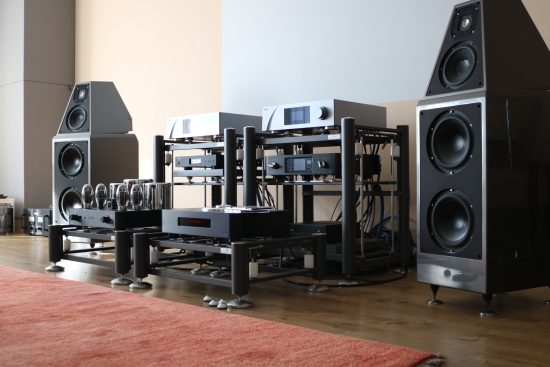
Where the Spirit III really excels is in being considerably more focused and more expressive. Even if I never had the feeling that the Scorpio was lacking in this area, the Spirit III simply reveals more in the way of textures and subtle details. It’s not only that it is better with microdetails but it also delivers these subtleties in a more lively and dynamic manner. Vocals are locked between the speakers with higher precision and the sense of space around the speakers is more variable. With the Scorpio, the “sound bubble” or image size is more or less constant but with the Spirit III, it depends more on the recording. This amp will sound small or large, precisely as required. And, as one would expect, the Spirit III is also more authoritative and more powerful. The extra power, in this case, is not accompanied by a more static sound or by a more bombastic sound but simply by sounding even more solid yet also more upbeat and with more definition in the bass and lower midrange.
The Scorpio offers incredible value already but the Spirit III absolutely further raises the bar significantly. It’s crazy how quickly one gets accustomed to a better sound. Going back to the Scorpio after having listened to the Spirit III for some time makes the former sound a little dull, even if it is in an absolute sense a very dynamic and lively performer, much livelier, in fact than any other tube amp of any other brand that I tried so far. After a couple of songs with the Scorpio, though, I could also get back into its sound and I must say that the KT88 tubes certainly have their specific charms as well.
In the Zanden review, I mentioned that I did not know of a tube amp that comes as close to the CH Precision A1 in terms of bass performance. Zanden is rightfully famous for combining tube strengths with transistor strengths. But although the Ayon Spirit III is not as refined, obviously high-res or as transparent as the nearly 22k euro Zanden 8120, it actually sounds even more impressive in the bass and lower midrange to me, and in these areas, it does indeed come even closer to the A1’s performance. Now, of course, CH Precision has further upped the game with their 33K euro A1.5 which takes the bass performance to even higher levels. Having directly compared these two amps I can be brief: the CH is still my reference. But, amazingly, the Spirit III comes way closer in terms of bass solidity, articulation, speed, and dynamics, than it has a right to. And, of course, since it is a tube amp, it does have a way with vocals that even the A1.5 cannot match.
Some may prefer a warmer, more relaxed or smoother presentation but for me, the amp provides a highly realistic experience and I don’t think that the stereotypical “tube warmth” is what tubes are about anyway. Besides potentially sounding smooth indeed (which is more the influence of the transformers and the circuit than the tubes themselves), tubes can also sound incredibly dynamic and lifelike, with rich midrange textures and a sense of 3D imaging that transistors usually do not achieve and the Spirit III is no exception. In fact, it has none of the mid-bass bloom that plagues so many tube designs, yet it sounds utterly natural to me. This is precisely what impressed me so much when I first heard the 12K euro Ayon Crossfire III SET amp and the Spirit III very much reminds me of it. The more Ayon products I hear, the more I come to think that their house-sound is mostly characterized by huge dynamics, tight bass and a decidedly non-filtered, real-life sound. And this is precisely the way that I like it.
Direct-In
Naturally, I also experimented with the amp’s direct input which bypasses its built-in preamp section. When connected this way, the Spirit III only took care of the amplification duties, leaving volume leveling tasks to the C1 DAC’s built-in digital/analog volume control. Interestingly, while the sound did indeed become more direct and slightly more transparent with the Spirit III’s preamp switched out of the circuit, the sound was also drier and now moved me less, emotionally. Also, the soundstage was considerably deeper and more 3D via the Spirit III’s built-in pre-amp.
This is something that I noticed with the Crossfire III as well, that apparently there is a great synergy between the amp’s pre-amp and power amp sections, which seems logical but is still interesting to find. I’ve often found that built-in preamps were something of an afterthought but this is clearly not the case with Ayon. Besides the Spirit III integrated amp, there is also the Spirit III-PA, which costs the same but is a pure power amp. I don’t know if it sounds precisely the same as the integrated via its direct inputs but it has the same specs and offers almost the same functionality. The difference is that the PA version is fully balanced (it has 4 line stage tubes rather than 2) and offers XLR as well as cinch inputs. Because the built-in preamp is so very good, however, I would opt for the integrated version and worry about potentially adding another preamp later.
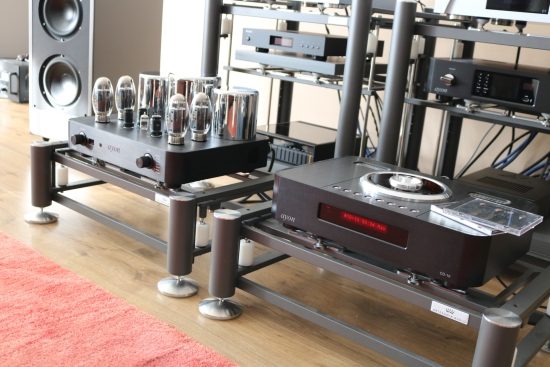
The Ayon CD-10 as a transport via coax into the Stealth DAC sounds fast and articulate and very expressive. As a transport, it is not quite as thunderously dynamic as the CD-T II, but very transparent and precise while retaining a nice fluidity. As a CD player, it has an even more beguiling quality, carefully threading the middle road between rich lushness and solidity with great dynamics.
DMP switch
There’s a new switch at the rear of the amp that the manual does not mention, which was not on any other Ayon amp so far, labeled DMP with 3 positions: 1, off, and 3. I asked Hein about this and as it turns out, this is indeed a new feature about which more information will be shared later on. For now, all that is indicated about this by the manufacturer is that one could use the “2” setting for speakers that are very difficult to drive. When I tried either the 1 or 2 setting, I found that this took away some of the amp’s distinctive enthusiasm, but then, the Wilsons are not that hard to drive in the first place.
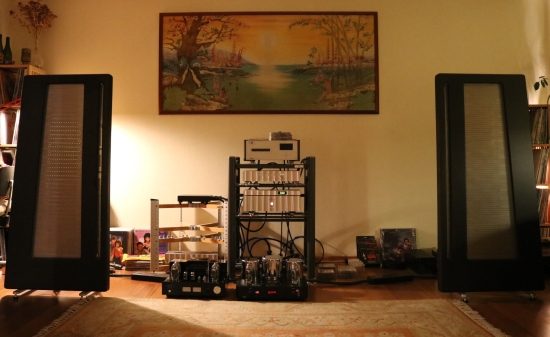
Listening at JW’s
After having achieved very interesting results using the Scorpio in audio buddy JW’s system, I now took the Spirit III to his place. As can be read in the Scorpio review, the latter sounded great but was ultimately just a bit underpowered to really properly drive JW’s Apogee Duetta’s at higher levels.
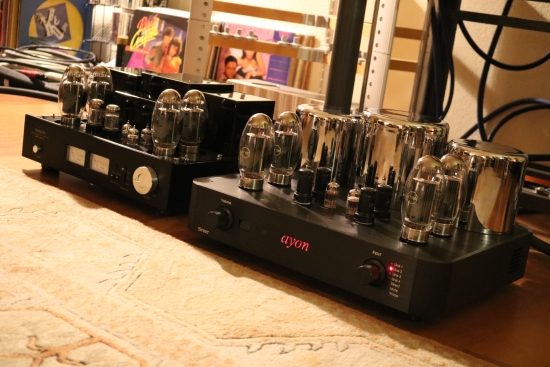
Now, the Spirit III may be only 20 watts more powerful, but subjectively, it is obviously more powerful, more sonorous and purer of sound as well. In spite of its higher power, it is very fast and articulate, even with the Duettas, which are infamous for making lesser tube amps sound slow and lifeless. Interestingly, contrary to the perception based on numbers alone, the Spirit III with its 65 watts, seems to better control the Duettas than JW’s 100-watt Line Magnetic LM-150IA. With these speakers, the latter is smoother and creamier and also more refined, but in JW’s system, too, the Ayon is closer to the feeling of a live performance.
Conclusion
The Spirit III makes music in a manner that makes it impossible to listen to passively. All Ayon products that I have heard so far sound dynamic and lively first and foremost and the Spirit fits right into this description. It sounds solid and full-bodied, but also rich in texture and emotionally involving yet without the round and creamy-rich presentation, that for some people is synonymous with typical tube sound. Indeed, amazingly, the Spirit III’s bass performance is on par with some of the best transistor amps that I have heard. Its performance is much like a live act: not obviously super-refined or very polished but highly energetic, dynamic and powerful, with articulate, fast and very solid bass to make for a delivery that is instantly infectious.

Previously a long-standing HFA favorite
External Links
Distributor for the BeNeLux: Mafico
Manufacturer: Ayon Audio
More Ayon
Ayon CD-T CD transport (mini review)
Ayon Stealth and CD-T-II
Ayon Sigma DAC
Ayon Orbis preamp (mini review)
Ayon Scorpio and S3-Junior
Ayon S10-II Signature
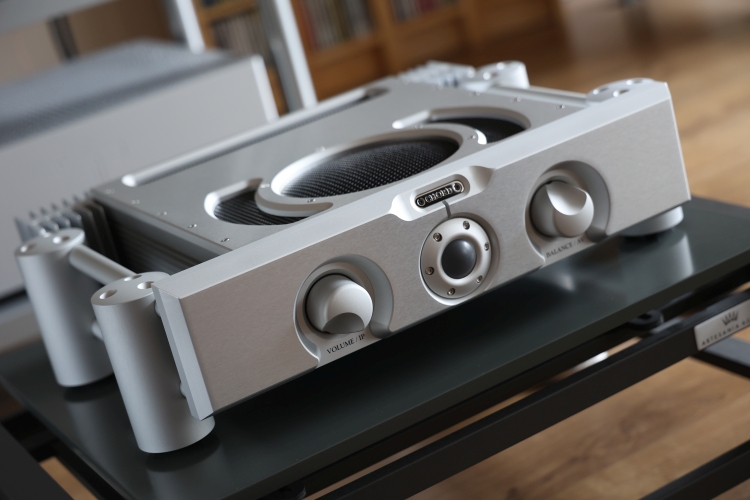
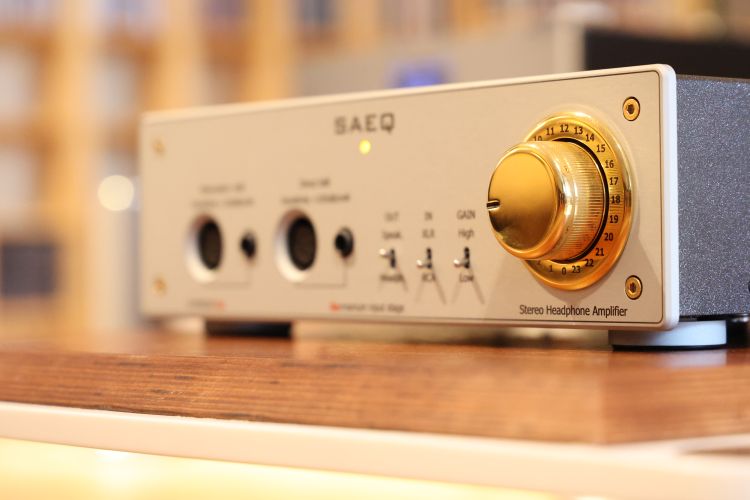
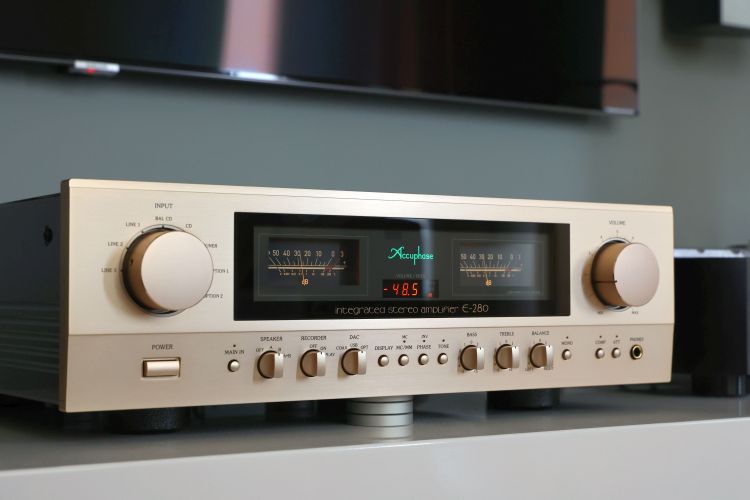
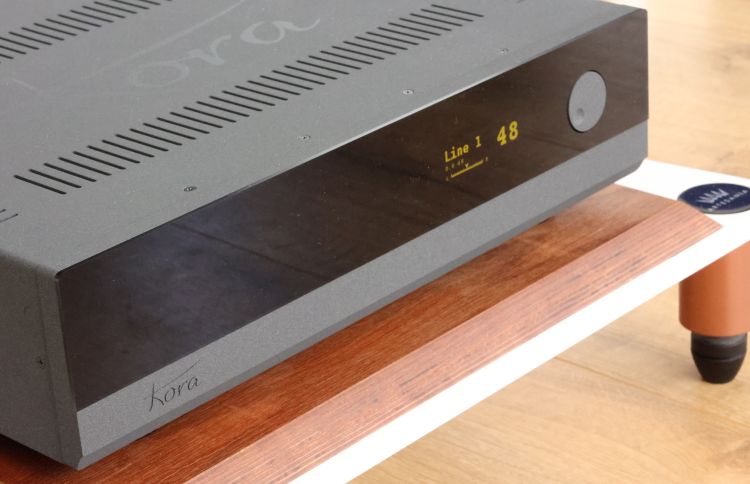
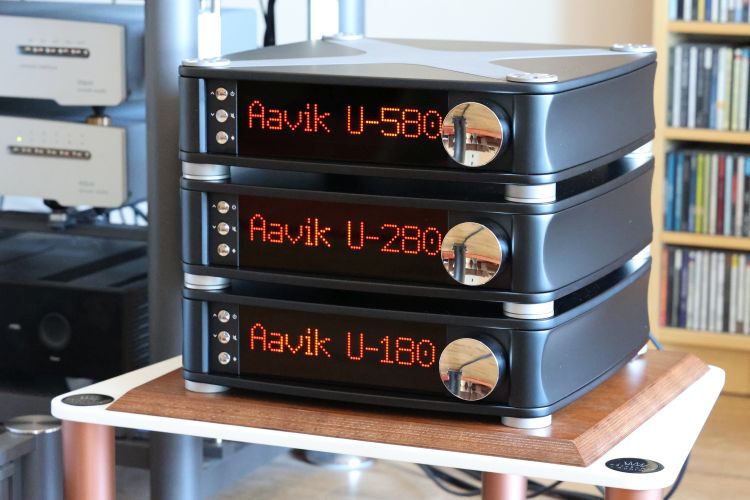
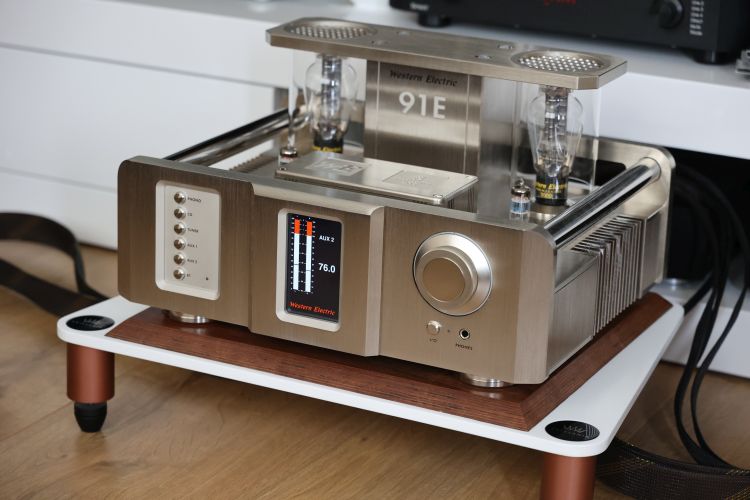
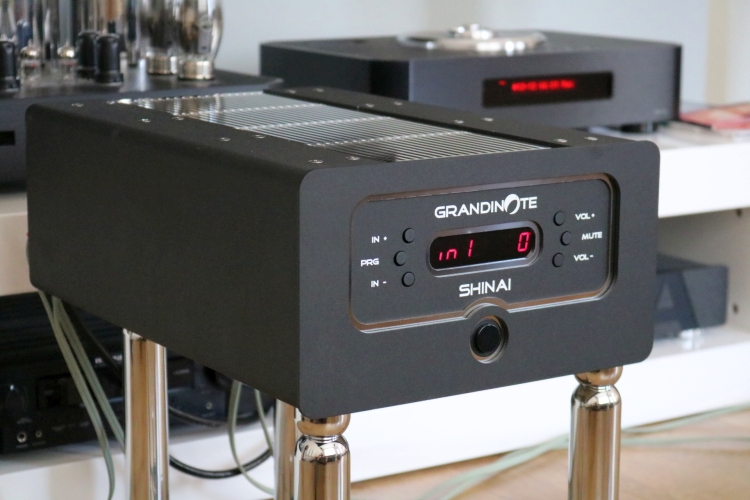
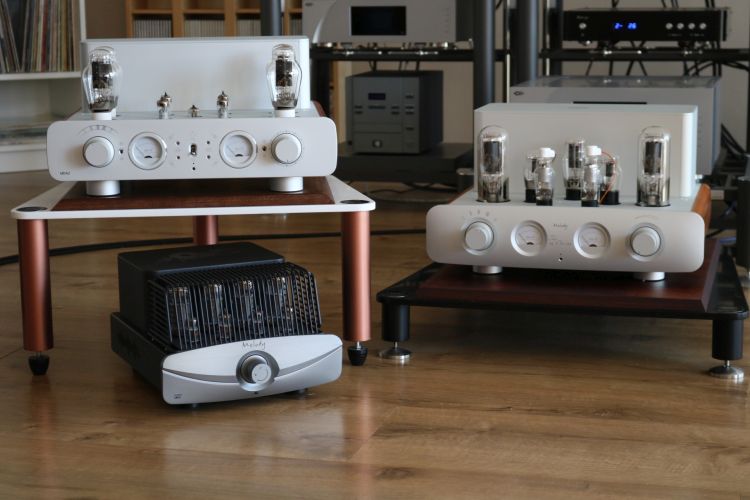
Can you give as a comparison between Ayon Spirit III and Audio Research Ref75 SE, because both amps are on KT150 tubes? Also, where is Nuprime st-10 in that relation? tnx
Even though the same tubes are used there is not a lot of similarity between Ref75SE and Spirit III. Yes, I can hear the KT150’s trademark qualities such as even-handedness, LF- and HF extension and bass tightness and articulation but otherwise these are two very different amps. The Ayon is first and foremost a solid and beefy sounding amp, reminiscent of a live-performance whereas the ARC is more a gentle and refined, audiophile kind of amp. Both deliveries do have their charm, though. The NuPrime ST10 is much closer to the Ayon overall, but is rhythmically even more assured and has even more solid and more powerful bass (this is its strong suit) but, naturally, the NuPrime does not have the more tube-typical midrange liquidity and heightened involvement with vocals and string instruments.
Hi, I am following your website since you had the 3.7 in the house and it’s a great source of information for which I am already grateful.
Would you mind asking if the Stealth DAC will be a step up vs DS Sr. as a DAC/pre combo straight into JR625s2 (powering Guarneri) for classical/acoustic?
As you can imagine already I am in the quest for tonality more than anything else and yes, CH is definitely out of my range…
Hi Riccardo, It’s nice to hear that you are a happy long-time reader! Can you clarify what you mean with “DS Sr”? I am assuming you mean the Linn Klimax DS but what does “Sr” stand for? Also, please state your intended source for the Stealth.
Hi Christiaan, apologies, I meant PS Audio Directstream DSD on Snowmass and the signal source is from a custom PC into Ultrarendu via USB, considering moving to Ethernet via JCat Femto board. Thank you already!
Hi Riccardo, ah, the DirectStream, ok. Well, those are very different DACs with pretty different presentations. While the PS Audio may be more hi-res, the Ayon is richer and more colorful but overall, I wouldn’t say that one is better than the other so it really comes down to taste. In any event, in all my experiments when I could compare SPDIF, USB, and I2S, the latter came out on top so if you have the possibility to take that more direct route (rather than via UltraRendu), then that would be my choice. Mind you, the Ayon also has I2S input but you’d need to check if it is compatible with the JCAT card.
And I forget, taking the direct route via Ethernet is also a good option and usually better than via an intermediate device that outputs via USB. That said, recent experiments with a Pink Faun I2S card and the Pink Faun 2.16X server into the Aqua Formula xHD DAC have shown real promise.
Hi Christiaan, really appreciated your feedback and suggestion about the card from PF. My first step in that direction is the etheRegen from Uptone.
More relevant to this review. How did you like the Ayon amps compared to the 625s2 playing with the Apogee? Really interested about your opinion before any audition in person since you had the JR for a long time.
Hi Riccardo, Ayon and Rowland have completely different presentations. Ayon excels in tonality and excitement while Rowland majors in refinement and low-level resolution. That said, I can tell you what I prefer with the Apogees these days and that is the Ayon. I find that as I grow older, I care more about energy, tonality and dynamics than the last bit of resolution or subtlety. The 625S2, almost as much as the model sixes, made the best of the Duetta’s MRTW ribbons, allowing the speakers to sound super-hi-res and highly refined at the same time and for the longest time, that was the ideal sound for me. The 625S2 has better grip on the bass and sounds more expressive than the sixes while retaining a warmish/smooth delivery. The Spirit III is not warm at all but still has a more natural tonality (less synthetic/filtered/processed) and it injects more “rock and roll” with more impressive dynamics. And, like many tube designs, it has a more magical and fascinating midrange. Do note: Duettas are insensitive but still relatively easy to drive and the Spirit III has no issues with them. Divas, however, are quite another story.
Hi Christiaan,
Could you give a more information on how spirit compares to lm 150ia? Is JW still satisfied with his 150ia and is there any power cable changes and any kind of tube rolling he has done? (I have nos brimars and ken-rads in v1 and v3 right now resulting warmer closer vocals and more details in all frequencies) As a happy owner of 150ia and JMLab 4 ohm Mezzo Utopias, I still keep a close eye on amps using kt150s. I wish we would have rolling options on kt150s.
The Line Magnetic LM150IA and Ayon Spirit III were reviewed with an interval so I’ve not heard them side by side in the context of my system. The only direct comparison was at JW’s place. As such, I’m not sure what more I could say about their relative differences. If you have any questions in particular just ask, and I will see if I can answer them. JW is still satisfied indeed because he very much likes the creamy-smooth sound that the LM has but every time when hearing the Spirit at my place he is also highly attracted to its lucid and lifelike midrange. So, I guess he is a bit torn between the two. Personally, in his system, I am more in favor of the more direct and timbrally more lifelike Ayon sound, even if it is also drier than with the LM. That said, the relationship between amp and speakers should not be underestimated and I can’t really draw conclusions from JW’s Apogee system alone. He’s not done any tube rolling just yet and, so far, neither have I. Honestly, I am actually happy that there is only one manufacturer for the KT-150’s as it keeps things simple. The Tung-Sols really are great and we can still swap the gain- and driver tubes:-)
Hi Christiaan and other readers
Last weekend I bought myself a Primaluna EVO 400 Integrated Amp.
This is the succesor of Primaluna Dialogue Premium HP which you already reviewed last year.
I am very happy with it so far!!!!
Cannot compare this amp with other tube amps since this is my first tube amp
Can you tell me what the position is of the Primaluna Dialogue Premium HP (= EVO400) compared with the Ayon Spirit III and the LM 150 IA ???
Are those 3 in the same range or are there big differences between them?
Seems to me they are in the same pricerange
I am especially very interested about your opinion how those 3 amps compare with each other hooked on the Apogee Duettas.
It is a pleasure to read your reviews, very interesting and detailled!!!!
Hope to hear from you
Thanks and kind Regards
Piet
Hi Piet, Glad you hear you like reading on HFA! The three amps are more or less in the same league but there are differences in presentation. Mostly, I would regard the Prima Luna as slightly less audiophile but that is not to say that it is not hugely enjoyable. The Prima Luna amp is very good indeed, not only for the money but it is one of the most powerful and solid sounding tube amps that I have heard, irrespective of cost and it even drives the Duettas very well. It’s also tonally perfect and very natural. But it also has a downside in which both the Ayon and Line Magnetic are better: resolution and overall refinement by which I mean subtle nuances such as low-level info and treble air and such. The Ayon is most solid and down to earth (as the Prima Luna also is) while the Line Magnetic is warmer and richer, smoother, too, if not quite as natural sounding than the Ayon and Prima Luna in terms of timbre. These differences can be heard with Duettas but also with Wilson WP8.
PS
I am very interested in how my Primaluna EVO400 will sound with Apogee Caliper or Apogee Duetta.
If someone of you has Apogees for sale please leave reply
Thanks and regards Piet
Hi Piet, I will ask around and will be in touch via PM (private message).
Hi Christiaan,
thanks for your reply,
interesting to read how you experience the differences between the Primaluna versus the LM and the Ayon , I almost begin to feel sorry that I bought a Primaluna instead of an Ayon (_:
As I wrote before ; this is my first tube amp and also my first “high end/ audiophile amp”.
My livingroom / mancave is packed with Quadrophenic amps and receivers from the 70-ties, Sansui QRX 6500, Pioneer QX 949 A, Fisher 514, Akai AS 980, JVC 4 VR 5456, and 20 more of such machines. (In those years Top of the Line)
Got my own Quadrophenic Museum (_:
I know ; they are out of date , not high-end, not really relevant in this forum, but who cares ?!?! You have to start somewhere , isn’t it ?????
I had a lot of pleasure with this antique stuff and never gonna sell these golden oldies….
I always liked the “warm sound”of these old machines!!!
Last few months I found it was time to make a step forward in my musicsystem ( it ‘s never too late (-: )
By reading your reviews ( and others) I became very interested in High-end Tube amps .
So that’s my story how I came to buy this fantastic Primaluna EVO400…….
…..No regrets at all so far…..
Now my next mIssion is to buy myself Apogees ( Duetta , Caliper or Centaur).
Also because your ( and other ) very good reviews about those speakers ( will this be a good choice you think ??) !!!
I am also open to other recommodations from your side about other speakers from other brands paired with my EVO 400 .
My livingroom is 8,40 m x 4,80 m, tiles on the floor, not many carpets.
I prefer speakers with strong midrange and treble, because it is easy to get bass in my room.
Again ; Thanks for the reply and all the information on your site, I enjoy myself very much and also learn very much !!!
Hope to keep contact ,
kind regards Piet
Hi Piet, well, there’s an upside to everything. Even if I don’t regard it as audiophile, some of my friends still refer to my DiaLogue Premium for its enthusiasm and involvement. Duetta, Caliper and Centaur will all work well with the EVO400. The decision between the models will come down to either the tightest and punchiest bass (Centaur) or the fullest, deepest bass (Duetta or Caliper).
Christiaan
Thanks for your reply, appreciate your detailled comments very much!!
Interesting to read about the differences between the Line Magnetic and Ayon vs Primaluna.
Still happy with my EVO400, hope you are willing to do a review on this amp in the future ….
I am still interested in Apogee speakers for my Evo400 primaluna.
Nevertheless I have been reading some positive reviews about GoldenEar Triton One speakers
Even Stereophile is very positive writing about these speakers.
Have you had any experiences with Goldenear speakers maybe??.
Need some tips/recommodations about which speakers will match best with my Primaluna.
My room is 8,40m x 4.80 m, tiles on the floor, few carpets…..
I focus more on midrange and treble then on heavy bass ( bass can be very dominant in my room).
I like clear ,clean, open ,bright sound….
I am open for any help or tips from you or other readers.
Thanks so far
Kind Regards Piet
Hi Piet, these days I am more focused on high-end and esoteric equipment so a review of the EVO 400 may not materialize any time soon. But you never know. Alas, I have no experience yet with Goldenear speakers. Your question regarding what speakers to take for the Prima Luna amp is too generic, way too many factors come into play, not least your personal preferences. Your room seems spacious enough for many speakers but size alone does not paint the full picture. A room can have very nasty resonances (dips and peaks) that make one speaker work better that another. It’s often a matter of trial and error, I’m afraid. But in any event I can tell you that there are no speakers that are like Apogees, they’re one of a kind. PS apologies for the delay, your response ended up in the spam folder… no idea why.
I have the GoldenEar 3+ speakers with a McIntosh MA252 intergrated hybrid amp. Out of the box, this system put too much of an emphasis on the treble and not enough on the lower midrange. To tame this imbalance and some occasional sibilance, I bought some darker speaker cables, am using no toe in, and I applied a 7 db cut with a .6 Q at 7700 hz. in JRiver’s parametric equalizer. Now I get glorious sound with plenty of bass and lower midrange. Four of GoldenEar’s speakers in its range of sizes have built in adjustable powered subwoofers, which is a nice feature to dial in just the right amount of bass. I am also using two 12 inch subwoofers.
Christian,
I’ve just come across this review and comments section. Top shelf, particularly your engagement with the readers.
I’m curious, can the Ayon be used with other tubes besides the kt150?
Glad to hear it, Jon. As for using other tubes, it is probably possible but not recommended by Ayon. Also, I have no reason to try this as I like the Spirit III just the way it is: very neutral and very lively yet still possessing of that tube magic. If you’d want to romantize the sound some more (just guessing here) then I’d suggest the Scorpio which uses KT88’s and has a very seductive sound.
Christiaan,
Thank you for your response.
Have you had the opportunity to hear either Primaluna Dialogue Premium HP (8 kt150s) or the ARC VSi75?
I really resonate with how your write your reviews, your focus on the sound, energy and pace of the music. I’m looking to get into a good tube integrated (the ARC I can get demo for the same price as the others)…but that doesn’t mean it’s as good, certainly not better.
I do like a little warmer sound, i.e., I like the VAC 200 and 300.1 amps, but I have a CJ MV50 which gives me plenty of tube-syrup. That said, I’m not a huge fan of the KT88, so I’m willing to give the KT150 a shot. Also, I will attempt to give the ARC and Primaluna a listen (Ayon is too far away).
Thanks again.
I just reread your comments stream and see the HP was noted in their in detail. NO need to refer to or repeat your comments. My apologies.
Hi Jon, Indeed, there is a review of the Primaluna HP monos on this site. Re ARC versus Ayon and PL, while I’ve not heard the VSi75 in a controlled environment I’ll assume that it sounds less precise but similar to the Ref75 that I know well. If that is the case, I’d say that ARC and Ayon are more audiophile, ARC sounds the least warm/rich and Ayon is more refined than PL. Between Ayon and PL, both have a sonorous and full-bodied sound where the Ayon is cleaner and PL more shut-in but easier on the ear.
Christiaan,
When you say the Ayon is more audiophile, do you mean resolving? Would you give soundstaging & imaging advantage to Ayon over the PL HP integrated?
Hi Jon, yes, more resolved, more linear, more transparent, better focus… this is explained in more detail in the Ayon reviews. Soundstage size is not too different, however.
Christiaan,
I’m wondering if you’d choose the Ayon over Primaluna Dialogue separates (non HP). I’m using Nola Contender speakers. Just your opinion. Thank you.
Hi Jon, While I’ve not heard the PL preamps nor your Nolas, based on what I heard from the PL power amps and for my personal taste I would choose Ayon.
I’ve got Cardas Golden Presence interconnects.
I generally but used and keep my cost to $150 per i/c. Do you have a recommendation within these parameters?
Also, I’m curious, have you heard any difference in components that are being supplied by 220 vs 110?
Thank you,
Jon
Hi Jon, sorry, I don’t have much if any experience with cables in that price range. I always felt and still do feel that in that range you are better off building your own cables using off-reel wire and good connectors.
The 220 vs 110 volts question is pretty much impossible to answer properly as one of the two components will always need a step-up/step down transformer which may or may not incur its own character. Furthermore, different schemes are used by manufacturers which can lead to different results. Theoretically, a linear transformer may not be bothered too much by 110 vs 220 if it is well-designed but it might sound different with 50hz or 60hzOf. Switched power supplies would theoretically be much more immune to such differences.
Of the times that I did try this (CD880EU vs CD880US, see the Classic Philips pages), there were too many other variables that make the comparison non-trust worthy.
Hello Christiaan,
Given that the Ayon amplifiers run in Class A and drive the tubes at a higher plate voltage, will they burn through tubes faster than a Class A/B amp? For 93 dB efficiency speakers, do you think the Spirit III would still offer sonic advantages over the Scorpio?
Have you had the opportunity to listen to the Octave Audio V40SE or V70 SE? If so, can you offer any comments about how they compare to the Spirit III?
Thanks for any comments. It’s very difficult to buy audio equipment these days when you can’t actually audition it anywhere.
Thanks, Drew Harty
Hi Drew, the Spirit III works in Class A only when in Triode mode. In Pentode mode, it is Push/Pull class A/B. But still, getting a concrete value from Gerhard regarding tube life is impossible:-) He maintains that it depends on too many factors and, of course, he is right. I am nowhere near the end of the tube life just yet and only hope to get many more years from them. Regarding Spirit versus Scorpio, this is not only a matter of power but also one of different personalities. Also in easy loads, the Spirit is tighter and more neutral and the Scorpio sweeter, warmer and more romantic. While I have heard Octave amps play on occasion, this was not in controlled environments and not in comparison with Ayon and so, while I liked their sound, I can’t comment on how they would compare with Ayon.
Hello Christiaan,
Thanks for the quick, informative response. I think I would enjoy the tighter, more neutral response of the Spirit, which is why I have been investigating integrated choices in addition to the Dialogue Premium or HP.
I have a large listening room with high ceilings and listen to music at moderately high levels. I use 3-way speakers that are 93 dB efficient but have two 8″ woofers wired in parallel that are driven at approximately 4 ohms. Would the HP be a better match for this setup than the Dialogue Premium?
Thanks again, Drew
Hi Drew, the Spirit drives the Kroma Carmens beautifully and with plenty of power reserve and they, too, have two woofers which I believe are wired in parallel. That said, crossovers can have a very large influence on the impedance and there could be dips that make the speakers harder to drive. But even then, I drove the Wilson WP8 very satisfactorily with the Spirit and these speakers definitely have more than a few difficult phase issues in the bass. Which is my long-winded way of saying that the Spirit will probably do fine but it remains something you’d have to try. The Dialogue Premium is less powerful than the Spirit, it drove the WP’s pretty well but not as confidently or as transparently as the Spirit. The Dialogue Premium HP is another matter. This is a very powerful amp, more so than the Spirit. Prima Luna does sound a little different from the Ayon meaning that this is subject to personal taste. Please read the PL Dialogue HP review for the specifics.
Hi Christiaan,
I’m inclined to try one of these – to experience tube amplification 🙂
Could you help me set my expectations about how this amplifier will sound with my WB Precision. P1.0s, compared to the combination of AGD Master 1 & AMG-STAs which I am currently running.
I’m asking based on my assumption that you know all these products well. Thank you for continuing to do what you do so well. Your recommendations still mean the most to me (clearly)!
Best wishes,
Jason
Hi Jason, that’s nice to hear, thanks!
Your question is a tough one to answer as I like all the components that you mention. They just have different strong points and that’s where personal preference comes into play. Basically, the AGD+NuPrime combo will exel in transparency, linearity, and resolution while the Ayon will exel in grooviness, upper bass robustness, and tonal saturation. If you haven’t yet, please read my WB P1.0 review for some more background.
Thank you for your reply Christiaan. I suspect I’ll enjoy both 🙂
… & if you had to choose one setup of the two, which would it be?
AGD+Nuprime+WB or Ayon+WB?
I’m interested in your taste here…
Fortunately, with two systems, I do not have to choose… 😉 But if I HAD to choose between these two as my one and only system? Well, as I am very happy with my very neutral and transparent CH system, and given that the AGD M1/NuPrime AMG-STA combo resembles the strong points of the CH L1/A1.5 combo more than the Ayon does, I think I would take that first route.
😆 I’m very happy with my AGD M1/NuPrime AMG-STA combo too. I’m curious about how the tube amp sound compares. So, until I can support two systems, I guess it’s up to me to try & find out which I prefer…
Thank you so much for sharing your pov Christiaan.